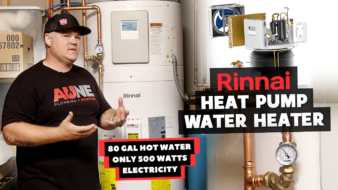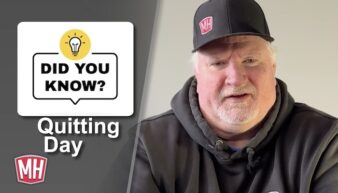That was the first question asked of my dad when I introduced my father, Larry Fenske to our Navien U.S. CEO Harrison Kim. Without missing a beat my dad looked at me with pride and for confirmation and stated “a cast iron boiler my son put in about 25 years ago and it’s still working great today.” Well that turned out to be both a loaded question for me, yet a right answer for him.
I was so happy to have the chance for my father to join me in Chicago at the 2014 ASPE Convention and Exposition even though it was following some sad circumstances. He was on his way home from a double family funeral in North Dakota. Stopping to see me, this was the first time I was able to show him the products I proudly represent along with introduce some of my coworkers with Navien. Included in our expo booth was our soon to be released NHB series hydronic condensing boilers.
His old boiler has served him well, as a former plant engineering manager with General Mills, my dad had the skills to clean and service his boiler, change the occasional igniter, circulator and zone valve. One thing that had been on his mind and of concern was his hot water tank that was reaching an age beyond the average years of service. In his 80s he would also someday be looking to downsize from the house that I grew up in. The combination of upgrading the mechanicals for the impending house sale while being able to add to his sense of security and appreciate potential energy savings all weighed on his mind.

Existing cast iron boiler installed in 1990 to be replaced with the 12-year-old 40-gallon gas water heater.
After Harrison confirmed it was a mid-efficiency boiler on the floor, and that my dad had a standard hot water tank, he stated with his usual exuberance “you have to try one.” And with that I knew I had my marching orders, the senior Fenske household located in a cold and snowy Buffalo, N.Y. would be getting an equipment upgrade.
With plenty of time to think about it and design the system I chose to go the multiple boiler route with a separate tankless water heater for the domestic.
My plan included meeting his desires of containing the entire system to an area under the stairs, and that’s where my challenge started. As I drew out the system on AutoCAD, it was immediately apparent to me that I could not make all the equipment fit under the stairs. I was mostly coming up short on space for the required plumbing and electrical. I have seen some beautiful equipment panels prefabricated in the field during my travels and then it struck me, why do I need to show the piping and electrical? Pre-building the mechanical system panel was the best thing I could have done because as it allowed me to switch over the domestic hot water within four hours, and the heating system was only off less than 24 hours.
With a structure heat loss just shy of 80,000 BTUs, five zones of heat, I chose to use two Navien model NHB-080, 80,000 BTU boilers. With the unique adjustable installer parameter capabilities I set the maximum fire rate of each boiler at 75%, 60,000 BTUs. This in conjunction with dialing the Grundfos variable speed boiler circulators to 6 GPM., I had a perfect boiler flow rate and system BTU overlap. Staging was done with the very simple to use Tekmar 263 2-Stage boiler panel and the system primary/secondary piping is achieved with a Spirovent Quad hydraulic separator. Using five Grundfos zone valves wired to a Navien circulator control panel, I separated the zone valves into two branches with two more Grundfos variable speed circulators pumping out to the aluminum finned copper baseboard. The security of redundancy was not only a factor in the multiple boiler choice but I also needed to address the zone pumping. This I accomplished by placing a crossover pipe on the discharge side of the circulators before the zone valves. That way with the pump directional flow protected by included check valves, if zone pump one failed to operate, and zone pump two was activated, I would have adjusted flow across all zones calling for heat.
The benefits of variable speed circulators and the options available, combined with their operational efficiency make them the way to go in most cases.

Taken at the September 2014 ASPE Exhibition in Chicago. Left to Right: Brian Dressel, Liz Sheehy, Harrison Kim, former Navien America CEO, now CO-CEO, KD Navien, Larry Fenske & Brian Fenske.
Some of the options I enabled and took advantage of with the Navien equipment enhanced the overall operation. Once setting the Tekmar panel parameters to operate the lead/lag and rotation of the boilers with appropriate timing I adjusted the Navien boiler parameters also. Navien parameters allows such features as controlling the modulation timing and burner ramp up firing rates. This with some other features such as timed temperature boost, anti-cycling and burner differential set-point selections allowed me to achieve and probably exceed the NHB series boiler published efficiencies. These and a few other installer operational settings will assure me a high-efficient, comfortable operation, as well as a long life expectancy of our hydronic system.
The exhaust venting is all done individually with 2” Sch 40 PVC, with the boilers having the first 8’ with Sch 80 CPVC. The old Chimney was repurposed as the common combustion air intake. I was fortunate to be able to reuse the existing ¾” black steel gas service because of the low input gas requirements of the Navien equipment. All current product Navien require just 3.5” W.C. inlet pressure. This allows me up to a 3” of pressure drop at full-fire from meter to the units. With 6.5” at the meter, I could run the almost 60’ with fittings and still have more than the adequate 3.5” W.C. inlet pressure to carry all units BTU potential at once.
The heating system has been in and operational for 3 months now, my mom and dad are tickled pink they can travel to visit the grandkids with no worries. For as long as their health holds they will enjoy their home in the cold Buffalo winters with no noticeable temperature swings or system noise, and enjoy the benefits of endless hot water when the house fills with visitors. One more thing, who doesn’t want to be comfortable and have minimal concerns of the cost of energy to do so?
Thank you to our Navien partners Watts, Tekmar, Spirovent, Grundfos and my old employer VP Supply for helping to make this happen.






Join the conversation: